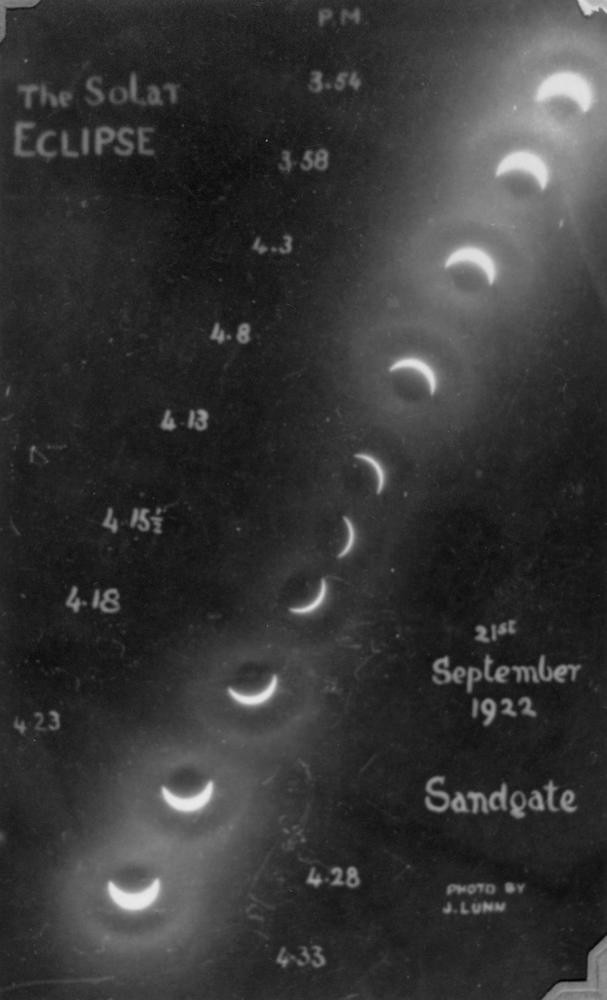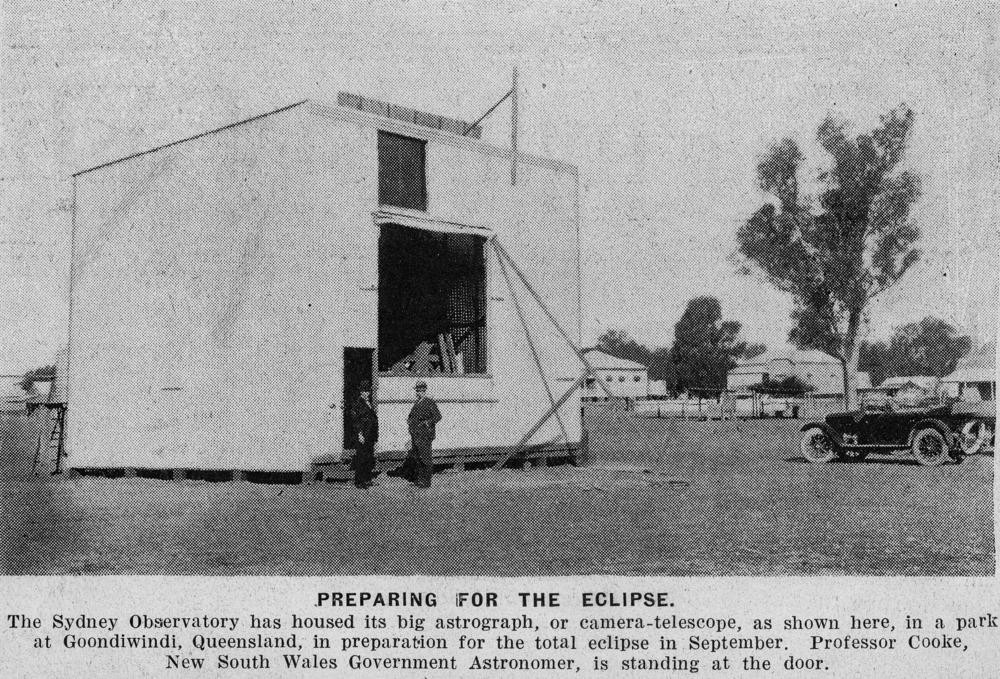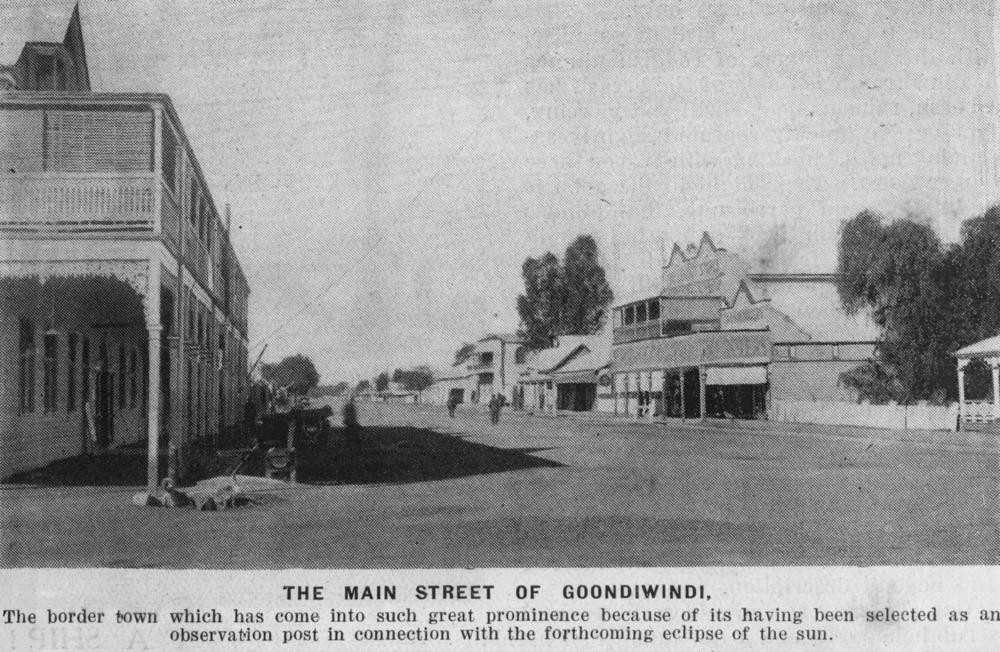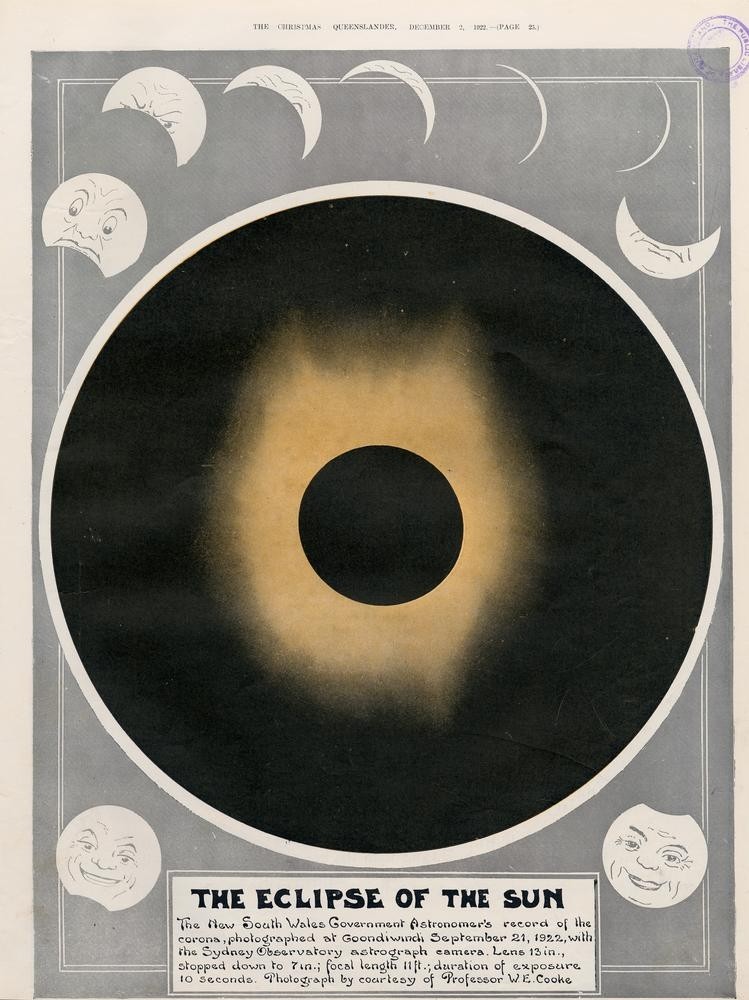Total eclipse of the sun 1922 and 2012
By Simon Miller, Library Technician, State Library of Queensland | 8 November 2012
2012 is a good year for rare astronomical phenomena in Queensland. In June we witnessed a transit of Venus and on 14 November North Queensland will be privileged to experience a total eclipse of the sun. While the total eclipse will only be visible in a relatively narrow corridor passing through the Cairns region, the rest of us will still experience a significant partial eclipse. In Cairns the partial eclipse will begin at 5:45 am with totality lasting around 2 minutes from 6:38 am, and the partial eclipse finishing at 7:40 am. In Brisbane there will be a significant partial eclipse of 84% between 5:56 am and 7:59 am.
The last time a total solar eclipse was visible in Queensland was in 1922 but we won’t have to wait quite as long for the next one. In 2028 a solar eclipse will pass over the south west corner of Queensland before heading towards Sydney, and this will be the first of three total eclipses visible in Queensland in a space of 10 years. In 2030 an eclipse will finish its path in southern Queensland and in 2037 the phenomenon will be visible over much of the south east.

Solar eclipse from Sandgate 1922
The 2012 eclipse is set to be celebrated with a huge festival of music and arts to be held north of Cairns near the Palmer River Roadhouse. In 1922 the interest was more scientific with teams of scientists from Sydney and Melbourne converging on Goondiwindi, a group from the British Astronomical Association (N.S.W. Branch) heading for Stanthorpe and a magnetic observer from the Carnegie Insitution setting up in Coongoola, north of Cunnamulla. The other major centre for scientific observations was at Wallal in Western Australia where a team from the Lick Observatory of California was at the centre of an international effort.
The chief concern of the astronomers at that time was to confirm predictions arising from Einstein’s Theory of Relativity. Einstein had predicted that light from the stars would be displaced by gravity as it passed close to the sun and a total eclipse was the only time that stars could be observed close to the sun before the advent of space travel. Observations during an eclipse in 1919 had agreed with Einstein’s predictions but further confirmation was needed as the expected displacement is very small and microscopic measurement of the photographic plates is required to detect the difference.

Observatory erected at Goondiwindi to view the eclipse in September 1922
A member of the Sydney University team at Goondiwindi, James Nangle, recalled the experience of the eclipse in an interview in the Sydney Morning Herald, the experience still vivid in his mind in 1937.
"A total solar eclipse is the most awe inspiring of Nature's phenomena," said the Government Astronomer (Mr. James Nangle) yesterday. "I shall never forget the spectacle of the total eclipse which I saw from a backyard at Goondiwindi, in South Queensland, in 1922.
"A scientific party, of which I was a member, rented a shop and we erected our apparatus in the backyard. For some days we each rehearsed our tasks so that when the great moment arrived, scientific observation could proceed as rapidly as possible.
"When the day did arrive we were nervous, excited, and on edge. Just before the total eclipse, shadow bands, about three inches wide and three inches apart, raced across the earth like millions of snakes. There was a galvanised iron fence at the back of the yard, and it seemed to me that reptiles were crawling all over it.
"Meanwhile, the moon was rapidly covering the face of the sun. The light became a bilious green. Animals became uneasy, and fowls, thinking that normal night was setting in, returned to roost. Then, suddenly, day turned to night. We were able to look toward the sun with the naked eye.
"The scene for three minutes was indescribably lovely and eerie. We saw the great streamers of the corona suspended from the disc of the moon. Their colour was a combination of silver and pearl. We saw, also, the chromosphere, which can best be described as a ring of rosy light at the outer edges. The chromosphere is irregular and its prominences extend for thousands of miles.
"There were two incidents during that eclipse that I shall never forget. I saw a crow, completely bewildered by the turn of events, endeavouring to gain a foothold on the revolving arm of a windmill.
"And there was the man from whom we rented the shop. Before the eclipse, he used to watch us making our preparations, but he was certain that there would not be an eclipse. He probably regarded us as a lot of crazy scientists.
"I saw him after the eclipse, which he had witnessed from a meadow, and he said that if anything similar was likely to occur again in Australia, he would leave the country."

Marshall Street Goondiwindi 1922
A rather more tongue in cheek assessment of the expedition was provided in the (Melbourne) Argus of 16 September 1922, in the lead up to the eclipse on the 21st by Oriel (an identity used by several writers for the Argus but at that time by John Sandes).
Back of Bourke and the Mulga there's a township on the plains,
Where there's nearly always sunshine and it hardly ever rains,
And the chaps who planned Australia were so hard up for a name,
That they called, it Goondiwindi and that was its only fame
There it lay, neglected, for a long, long stretch of years,
its streets were oft deserted, except by herds of steers,
And the raucous shouts of the stockmen, and the pistol crack of the whips,
Were Gundy's chief amusements before the big eclipse
Then the news ran round the stations, and raised the squatters' hopes,
When the scientists got busy and unpacked their telescopes,
And the cowmen flocked, to the township in eagerness to see
The testing of Einstein's theory of relativity.
There was Long Jim Smith and his cobbers, and Shorty, the lasso king,
And they gathered around the scientists in a tough but admiring ring,
And Old Man Smith from the Seven Mile leaned up against the bar.
And cried in a voice that was hoarse with beer, 'The star, me boys the star!"
There were telescopes and cameras and gadgets by the score -
Then Baldwins crowd from Melbourne town brought just as many more.
Yet still they came, those scientists, in dozens and in scores,
Until the Goondiwindians were forced to close their doors.
By train they came and motor-car, by horse and four-wheeled trap -
Goondiwindi smiled serenely - it was once more on the map;
And the squatters and the cowmen, why, their knowledge scientific,
defies all explanation. It was simply- well, terrific!

Illustration of the eclipse from The Queenslander 1922
The John Oxley Library holds several publications put out in anticipation of the eclipse in 1922. A short history of Goondiwindi and The Macintyre : together with explanatory matter and useful information concerning the Solar Eclipse which will occur on Thursday, September the 21st, 1922 issued by the Goondiwindi Argus has a history of Goondiwindi from 1840 compiled by Edgar Browne, apparently a grandson of one of the original pioneers, Sampson Marshall, and useful information about the eclipse and astronomy in general by J. Short (F.R.A.S.)
Total solar eclipse : visible as total or partial throughout Australia by C. A. Macfarlane was published in Brisbane as a popular guide for amateur observers, photographers, schools, and the general public in August 1922.
The total eclipse of the sun : 21st September, 1922, Australia by H. A. Hunt, Commonwealth Meteorologist was the official government guide to the eclipse. This guide includes information on the towns from which the eclipse could be observed including transport options and facilities available. For instance Coongoola at the far end of the Western Railway is described.
Coongoola itself consists of a very small galvanized-iron railway station, and a small galvanized-iron hotel. Nothing else is in view except the Longlands homestead, over 2 miles back along the rails. Living accommodation of a homely character would be provided by Mrs. Kruck, landlady of the hotel, if reasonable notice is given. There are several bedrooms, and other rooms which can be temporarily converted. Altogether, arrangements can be made for 20 to 30 guests.
I wonder what Mr D. G. Coleman of the Carnegie Institution thought of the place.
Simon Miller – Library Technician, State Library of Queensland
Comments
Your email address will not be published.
We welcome relevant, respectful comments.